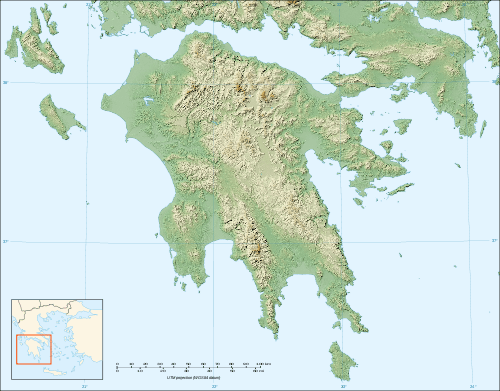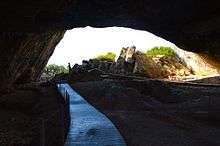Franchthi Cave
| Σπήλαιον Φράγχθι (in Greek) | |
|
entrance to the Franchthi Cave seen from Koilada | |
 Shown within Peloponnese  Shown within Peloponnese | |
| Alternate name | Frankhthi cave |
|---|---|
| Location | Koilada, Argolis, Greece |
| Region | Argolis |
| Coordinates | 37°25′24″N 23°07′56″E / 37.42333°N 23.13222°ECoordinates: 37°25′24″N 23°07′56″E / 37.42333°N 23.13222°E |
| History | |
| Periods | Paleolithic to Neolithic |
| Site notes | |
| Public access | yes |
Franchthi cave or Frankhthi cave (Greek: Σπήλαιον Φράγχθη) is a cave overlooking the Argolic Gulf opposite the village of Koilada in southeastern Argolis, Greece.
The cave was occupied from the Upper Paleolithic circa 38,000 BCE (and possibly earlier)[1] through the Mesolithic and Neolithic periods, with occasional short episodes of apparent abandonment.[2] Last occupied around 3,000 BCE (Final Neolithic), it is one of the very few settlements in the world that shows nearly continuous human occupation for such an extended period of time, and is one of the most thoroughly studied sites from the stone age in southeastern Europe.[3]
Excavation History
Professor T.W. Jacobsen, Professor of Classical Archaeology and Classical Studies at Indiana University, began excavations at Franchthi Cave in 1967. The dig was only intended to temporarily occupy Jacobsen, and his fellow researcher, M.H. Jameson, for one short season, while they waited for land use issues to be resolved at a nearby site. But it soon became clear that Franchthi cave was more important than they had anticipated.[4] The excavation, overseen by Jacobsen, would continue for nearly a decade, ending in 1976. Since then numerous scholars have examined the extensive finds.[5]
Paleolithic
During much of its history Franchthi was significantly further from the coastline than it is today, due to lower sea levels that have since risen around 400 ft.[6] Thus, its inhabitants looked out on a coastal plain that was slowly submerged over the course of their occupation.[7]
During the Upper Paleolithic Franchthi Cave was seasonally occupied by a small group (or groups), probably in the range of 25 - 30 people, who mainly hunted wild ass and red deer, carrying a stone tool kit of flint bladelets and scrapers.[8] Its use as a campsite increased considerably after the Last Glacial Maximum (LGM), with occasional hiatus in the sequence of occupation.[9] Obsidian from the island of Melos appears at Franchthi as early as 13,000 BCE, offering the earliest evidence of seafaring and navigational skills by anatomically modern humans in Greece.[10] (There is evidence that suggests ancient mariners - such as Homo Erectus or Homo Heidelbergensis - may have reached Crete at least 130,000 years ago.)[11][12]

Mesolithic
An apparent break in the occupation of Franchthi cave occurred during the Younger Dryas climate cooling event,[13][14] after which a Mesolithic culture appeared as the world settled into the warm Holocene climate that continues today. The Mesolithic is represented by only a few sites in Greece, and, like Franchthi, nearly all of them are close to the coast.[15] They did not rely as heavily on big game as their predecessors, probably due to the changing climate and environment; instead they broadened their resource base to include a variety of small game, wild plants, fish and mollusks.[16] The evidence of increased fish bones and increased use of obsidian from Melos at Franchthi during this period shows they were accomplished seafarers.[17] There is a notable stretch spanning several hundred years (circa 7,900 – 7,500 BCE) when tuna became a major part of the diet at Franchthi cave,[18] implying deep sea fishing. It has also been suggested that the tuna could have been caught by placing nets near the shore.[19][20] A few graves have been found buried in the cave during the Mesolithic that suggest care for the dead.[21]

Neolithic
The cave also contains some of the earliest evidence for agriculture in Greece. Around 7,000 BCE[22] the remains of domesticated plants and animals are found among the usual wild plant and animal species hunted and gathered during the Mesolithic, suggesting that either the inhabitants of Franchthi had begun to practice agriculture or were trading for seeds and meat with the Neolithic people who had recently arrived from the Near East.[23] There has been some debate about whether agriculture developed locally in Greece, or was introduced by colonists. It is now generally believed that emigrants from the Pre-Pottery Neolithic B cultures of the Near East arrived by boat at the beginning of the seventh millennium BCE to settle Greece(c.6,900 BCE), introducing agriculture.[24] For some time the evidence from Franchthi was used as an example in support of locally developed agriculture, but more detailed study of the remains has demonstrated that the evidence supports the foreign introduction of domesticated plants and animals.[25] The Mesolithic hunter gatherers of Greece rapidly adopted the methods introduced to them by Neolithic colonists, including at Franchthi Cave.[26] During the Neolithic main occupancy of the cave shifted to an area outside the entrance, called the Paralia (the seaside),[27] where terracing walls for growing crops were built.[28] It is believed the inhabitants also occupied a village below the Paralia, which is now submerged beneath the sea. Several anthropomorphic and zoomorphic figurines have been recovered at Franchthi from the Neolithic era,[29] and it has been suggested that the site may have served as a workshop for making cockle-shell beads to trade with inland communities during the Early Neolithic.[30] The cave and the Paralia were abandoned around 3,000 BCE.
References
- ↑ K. Douka, C. Perles, H. Valladas, M. Vanhaeren, R.E.M. Hedges, (2011). "Franchthi Cave revisited: the age of the Aurignacian in south-eastern Europe." Antiquity 85 : p.1146 http://www.academia.edu/1129937/Douka_K._Perles_C._Valladas_H._Vanhaeren_M._Hedges_R.E.M._2011._Franchthi_Cave_revisited_the_age_of_the_Aurignacian_in_south-eastern_Europe._Antiquity_85_1131-1150
- ↑ Mary C. Stiner, Natalie D. Munro (2011) "On the evolution of diet and landscape during the Upper Paleolithic through Mesolithic at Franchthi Cave (Peloponnese, Greece)", Journal of Human Evolution p.619
- ↑ K. Douka, C. Perles, H. Valladas, M. Vanhaeren, R.E.M. Hedges, (2011) p.1133
- ↑ Colin Renfrew (1994) "Review of Excavations at Franchthi Cave, Greece by T.W. Jacobsen" Journal of Field Archaeology Vol 21, No. 3, pp. 378-379
- ↑ William R. Farrand, (2003) "Depositional environments and site formation during the Mesolithic occupations of Franchthi Cave, Peloponnesos, Greece" The Greek Mesolithic: Problems and Perspectives, The British School at Athens p.69
- ↑ Vivien Gornitz, (Jan 2007), "Sea Level Rise, After the Ice Melted and Today" http://www.giss.nasa.gov/research/briefs/gornitz_09/
- ↑ William R. Farrand, (2003) p.69
- ↑ T.W. Jacobsen, "Franchthi Cave and The Beginning of Settled Village Life in Greece" Hesperia 50:4, 1981 p. 306 http://www.ascsa.edu.gr/pdf/uploads/hesperia/147874.pdf
- ↑ Mary C. Stiner, Natalie D. Munro (2011) p.619
- ↑ N. Laskaris, A. Sampson, F. Mavridis, I. Liritzis, (September 2011) "Late Pleistocene/Early Holocene seafaring in the Aegean: new obsidian hydration dates with the SIMS-SS method" Journal of Archaeological Science, Volume 38, Issue 9, pp.2475–2479
- ↑ John N. Wilford, (February 15, 2010) "On Crete, New Evidence of Very Ancient Mariners" New York Times http://www.nytimes.com/2010/02/16/science/16archeo.html?_r=0
- ↑ Heather Pringle, (February 17, 2010) "Primitive Humans Conquered Sea, Surprising Finds Suggest" National Geographic http://news.nationalgeographic.com/news/2010/02/100217-crete-primitive-humans-mariners-seafarers-mediterranean-sea/
- ↑ William R. Farrand (2003)p.74
- ↑ Catherine Perles, (2003) "The Mesolithic at Franchthi: an overview of the data and problems" The Greek Mesolithic: Problems and Perspectives, The British School at Athens p.80
- ↑ Cathrine Perles, (2001) "The Early Neolithic In Greece" Cambridge University Press p.22
- ↑ C. Perles, (2001) p.28
- ↑ Tracy Cullen (1995) "Mesolithic mortuary ritual at Franchthi Cave, Greece" Antiquity 69 p.273 http://www.academia.edu/558881/Mesolithic_mortuary_ritual_at_Franchthi_Cave_Greece
- ↑ C. Perles, (2001) p.28
- ↑ C. Perles (2003) p.81
- ↑ Mary C. Stiner, Natalie D. Munro, Britt M. Starkovich, (2012) "Material Input Rates and Dietary Breadth During the Upper Paleolithic through Mesolithic at Franchthi and Klissoura 1 Caves (Peloponnese, Greece)" Quaternary International 275, p.37, http://www.researchgate.net/publication/238002490_Material_input_rates_and_dietary_breadth_during_the_Upper_Paleolithic_through_Mesolithic_at_Franchthi_and_Klissoura_1_Caves_%28Peloponnese_Greece%29
- ↑ T. Cullen (1995) p.270
- ↑ C. Perles (2001) p.91
- ↑ C. Perles (2001) p.46-48
- ↑ C. Perles (2001) p.45-46,52
- ↑ J.M. Hansen (1992) "Franchthi cave and the beginnings of agriculture in Greece and the Aegean." Prehistoire de l'agriculture. Nouvelles approches experimentales et ethnographiques, CNRS, Paris pp.231-47
- ↑ C. Perles (2001) p.56
- ↑ C. Perles (2001) pp.48-49
- ↑ C. Perles (2001) p.292
- ↑ L.E. Talalay (1993) "Deities, Dolls, and Devices. Neolithic Figurines from Franchthi Cave, Greece" Excavations at Franchthi Cave, Greece, fasc. 9, Indiana University Press, Bloomington and Indianapolis
- ↑ C. Perles (2001) pp.224-226
>
Bibliography
- Farrand, William R. 1999. Depositional History of Franchthi Cave: Sediments, stratigraphy, and chronology. Fascicle 12 in the series Excavations at Franchthi Cave, Greece. Bloomington, Indiana: Indiana University Press. ISBN 0253213142. OCLC Number 41503459
- Galanidou, Nena and Perles, Catherine (editors). 2003. "The Greek Mesolithic: Problems and Perspectives" London: The British School at Athens
- Perles, Catherine. 2001. "The Early Neolithic In Greece". Cambridge University Press.
External links
- http://www.academia.edu/4865809/Deities_Dolls_and_Devices_Neolithic_Figurines_from_Franchthi_Cave_Greece
- http://www.ime.gr/chronos/01/en/index.html
